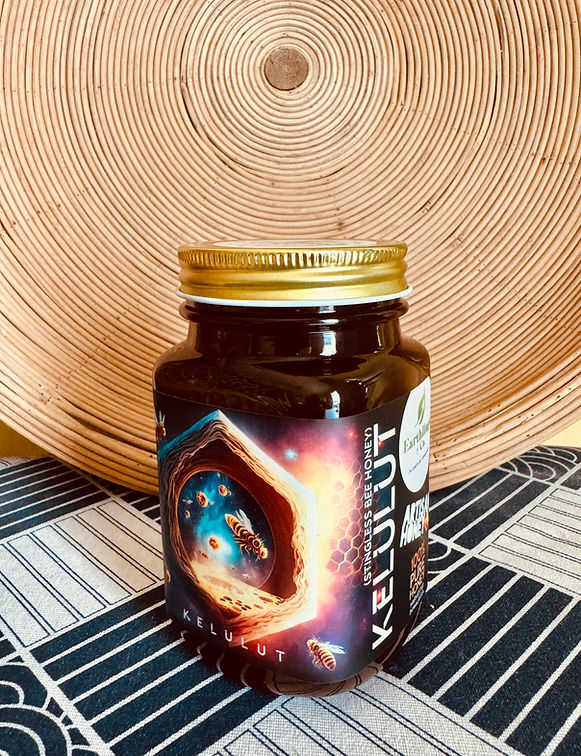A superfood of super
nutritious proportions!
-The Natural Observer

Kelulut honey has gained popularity due to its acclaimed health benefits and unique flavor profile. It contains various vitamins, minerals, and antioxidants, similar to honey produced by honeybees. Studies have shown that kelulut honey have much higher levels of certain antioxidants compared to regular honey.
Rich Source
of Nutrition
& Antioxidants
Kelulut honey, also known as stingless bee honey, is a type of honey produced by stingless bees, often of the genus Melipona or Trigona. These bees are native to equatorial regions, especially in Southeast Asia, including Malaysia.
Kelulut honey has gained popularity due to its acclaimed health benefits and unique flavor profile. It contains various vitamins, minerals, and antioxidants, similar to honey produced by honeybees. Studies have shown that kelulut honey have much higher levels of certain antioxidants compared to regular honey.
The taste of kelulut honey is often described as tangy, slightly sour, and sometimes even fruity, depending on the plants the bees feed on. It's used not only as a sweetener but also in traditional medicine for its supposed medicinal properties, including wound healing, cough relief, and immune system support.
.jpeg)
Quality
Assured
We do not compromise
on the authenticity of our
products. They are nothing short of 100% natural.
Sustainably
Harvested
Harvesting of coconuts
was done in a manner that safeguarded the delicate balance of the ecosystem.
Organically
Certified
Our coconuts & all other products have gone through rigorous lab test & are certified to be organic.
100% Pure -
Harvested in Malaysia
Our harvesting of kelulut honey in Malaysia involves specialized techniques tailored to the behavior and biology of stingless bees (kelulut bees) to ensure minimal disruption to the colonies and the sustainability of honey production. Here's an overview of the typical process:
1. Identification of Colonies:
Beekeepers locate kelulut bee colonies, often found in tree hollows, termite mounds, or specially designed artificial hives. These colonies may be situated in various natural habitats, including forests, gardens, or orchards.
2. Observation and Monitoring:
Prior to harvesting, beekeepers observe and monitor the colonies to assess their health, population size, and honey production. This helps determine the optimal timing for harvesting and ensures that the colonies are strong and healthy.
3. Selection of Harvestable Colonies:
Beekeepers select colonies that have sufficient honey stores and are deemed ready for harvesting. It's essential to leave enough honey for the bees' sustenance and to support the colony's growth and reproduction.


Great Benefits of Kelulut
Honey
Kelulut honey, produced by stingless bees, is often praised for its potential nutritional properties. While detailed nutritional data may vary depending on factors such as the region, floral sources, and processing methods, kelulut honey generally contains the following components:
-
Carbohydrates: The primary component of honey is carbohydrates, mainly in the form of sugars such as glucose and fructose. These sugars provide energy and sweetness.
-
Proteins and Amino Acids: Honey contains small amounts of proteins and amino acids, the building blocks of proteins. While these amounts are not significant compared to other protein sources, they contribute to the overall nutritional profile.
-
Vitamins: Kelulut honey contains trace amounts of vitamins, including vitamin C, vitamin B complex (such as B1, B2, B3, B5, and B6), and vitamin K. However, the concentrations of these vitamins are relatively low compared to other food sources.
-
Minerals: Honey contains various minerals, such as potassium, calcium, magnesium, phosphorus, and trace amounts of other minerals like zinc and selenium. These minerals play essential roles in various physiological processes in the body.
-
Antioxidants: Honey, including kelulut honey, contains antioxidants such as flavonoids and phenolic compounds. These antioxidants help neutralize harmful free radicals in the body and may contribute to overall health and well-being.
-
Enzymes: Honey contains enzymes such as glucose oxidase, invertase, and catalase, which play roles in honey's antimicrobial properties and the conversion of sugars.
It's important to note that the nutritional composition of kelulut honey can vary depending on factors such as the botanical origin of the nectar, bee species, geographical location, and processing methods. Scientific research on kelulut honey's specific nutritional properties and health effects is ongoing and many new findings are emerging.

.jpeg)